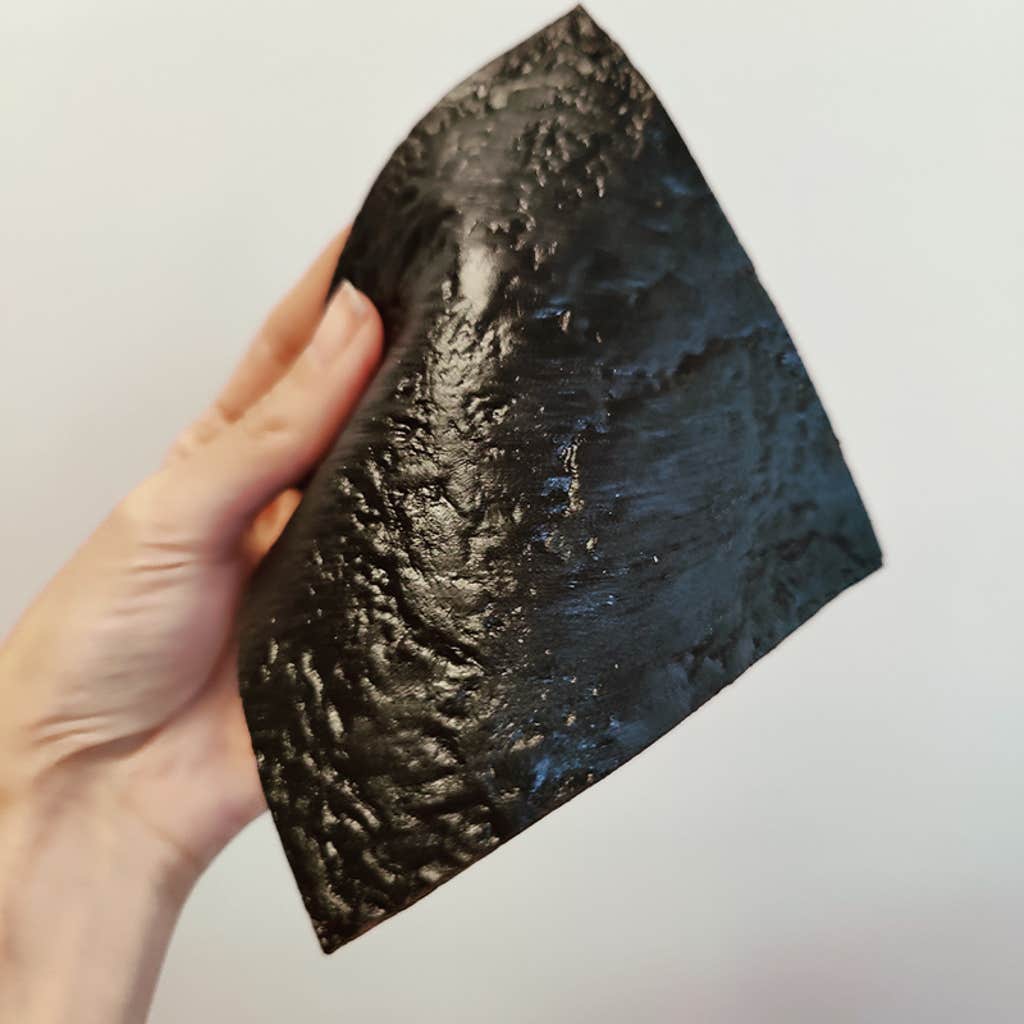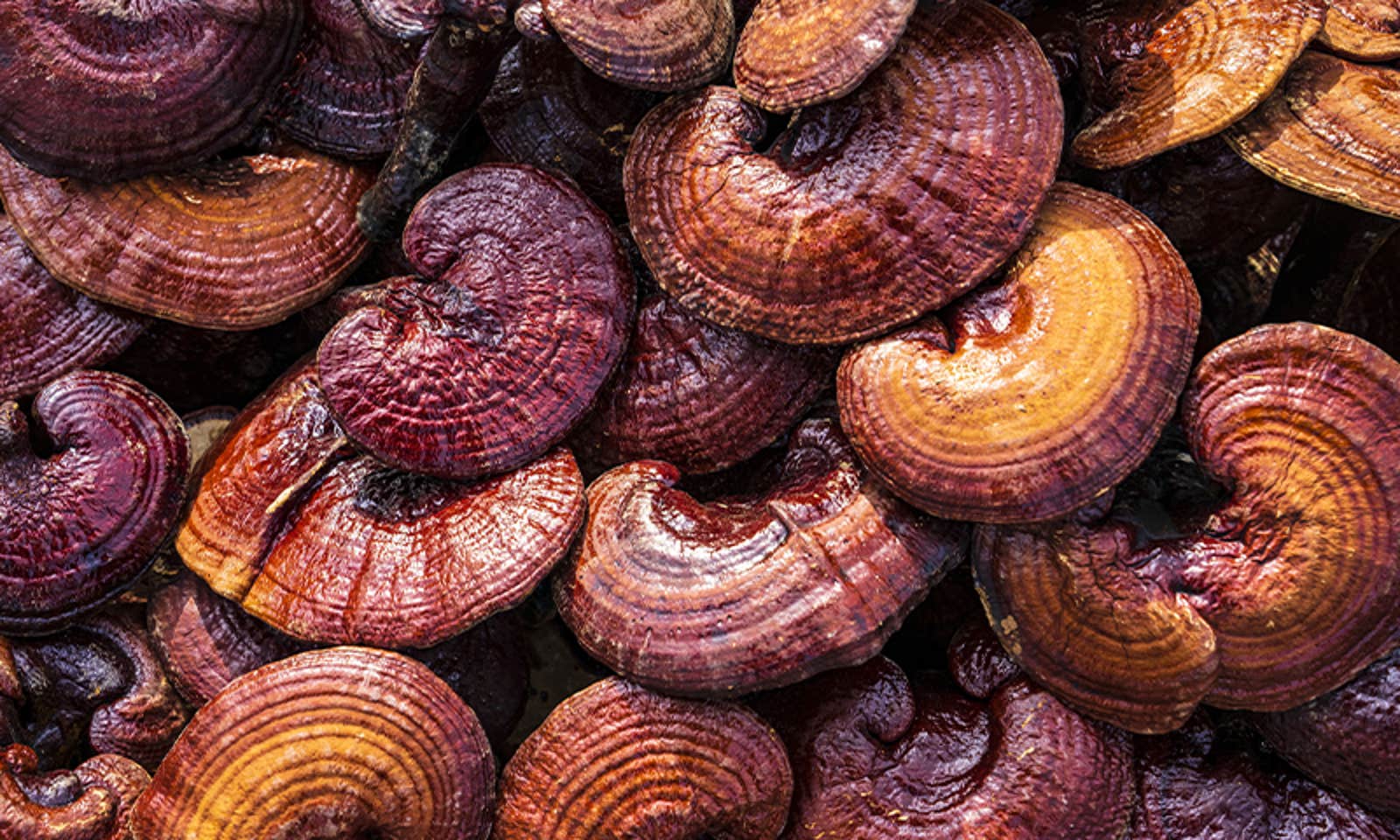The following recipe comes with a twist. Take a ½ cup of whole wheat flour and add ½ teaspoon of malt extract, ¼ teaspoon of cream of tartar, 1 tablespoon of xanthan gum and a dash of citric acid (lemon juice might do), then dissolve the mixture in 2 cups of water. Line a square baking tray with the resulting paste, sprinkle with mushroom spores (preferably reishi) and leave in the dark for 2 to 3 weeks. After that time, according to a new study by Assia Crawford and her colleagues, you may have grown enough fungal leather to fashion yourself a one-of-a-kind coin purse.
“At this point what we’re producing is not in the realm of day-to-day leather shoes, from a durability standpoint,” says Crawford. She is still tinkering in the lab with small-scale batches. But in theory, she says, a future is possible where most leather products are replaced by mushroom-derived alternatives.
Crawford is not the first to experiment with leathers made of mushrooms. Brands including Lululemon, Stella McCartney, and Hermès already use fungal fabrics in some high-end products, but most of these fabrics are expensive because making them is slow and labor-intensive. Crawford, who runs a bio-design lab at the University of Colorado, Denver, aims to design a new technique that will be so cheap and easy that these bio-designed fabrics could eventually out-compete traditional leathers made from animal hides and even faux leathers made from petroleum-based products.

To the touch, fungal leather feels a lot like leathers made from animal hide—supple, with a patchy texture. But the finish varies depending on how the fungal mats are treated after they are grown. A discerning user will more likely notice a difference in scent rather than one in appearance—fungal leather has an earthy, woody fragrance. But unlike sturdy leathers made from animal hide, Crawford’s mushroom leather is so soft that it can be easily scratched or damaged. So she imagines that, in the near-term, the material she’s making might end up as a lining for objects that don’t experience a lot of wear and tear, such as acoustic baffles that are hung from ceilings to reduce noise in open spaces, finishing touches to interior design, or “anything where perhaps you want that softer, gentler feel.”
Fungi are the invisible builders of the world, their bodies largely concealed inside soil. They are made of mycelium, a fabric that can assume a variety of textures and shapes. Mycelium can be tough enough to break through concrete or take on a shape that is fine as a silk feather. Just like plants have given us materials ranging from hardwood to cotton, fungi hold vast untapped potential for the development of construction materials or fabrics. Mycelium contains chitin, a complex molecule that is a primary component in the exoskeletons of insects and crustaceans and that is tougher than plant cellulose, which gives wood its hardness and cotton its toughness. Chitin can be flexible or durable or both, depending on the composition of the rest of the fungal tissue.
A future is possible where most leather products are replaced by mushroom-derived alternatives.
For candidate fungi species that would be suitable for leather production the researchers looked for the fastest colonizers, species that could grow quickly on a surface, outcompeting other microorganisms that may be present as spores in the air, Crawford said. “This is in the interest of making this viable,” she adds. To scale-up a process for industry, consistency in quality is paramount, and contamination is a major issue. In the end, “we narrowed it down to two species—Ganoderma lucidum, the reishi mushroom, which we see in traditional Chinese medicine, and pink oysters,” Crawford says.
Once the reishi or pink oysters (Pleurotus djamor) have grown, they form a surface an inch thick inside the baking trays. The reishi condenses into a uniform cream-colored mat, whereas the pink oysters acquire a rich sculptural pattern, which Crawford says she is especially drawn to. The next steps are to peel the mat off the growth paste with a spatula, then compress it with heat to a thickness of 2-3 millimeters, the same as conventional leather. A tanning process identical to the one used in leather manufacturing can have similar effects on these fungi mats, strengthening the fabric. But Crawford prefers to experiment with a process that relies on natural alternatives, like dying with blue-green algae.
The contemporary field of bio-design—which uses and is inspired by living organisms—is young, says Crawford. It’s just a couple of decades old and has grown out of a passion shared by scientists, designers, and architects to find sustainable alternatives for materials that have been mass-produced since the industrial revolution, and whose production or use harms the environment. Leather is one such commodity. Besides the objectionable practice of killing animals for their hides, the chemical tanning processes used to make animal-based leather tend to pollute freshwaters.
Once a hide is stripped off an animal carcass, it is fragile and would erode quickly if not for the chemical treatments. Slow, natural tanning such as soaking the leather in water infused with tree bark and ground nuts was common practice before the 1800s, but it can take weeks to achieve the same effect as submerging the material overnight in a synthetic solution rich in heavy metals, an industrial practice which has commodified leather. Many tanning factories in major leather producing nations, such as India, Pakistan, and Thailand, release wastewater from these synthetic processes that then contaminate rivers. And while faux-leather alternatives do not directly involve the killing of animals, many of the materials used to make them are plastics derived from fossil fuels, which means they are not biodegradable.
The twist in the recipe above is that the paste must be sterilized before it can be used to culture fungi, otherwise you stand a good chance of growing a field of yeast or bacteria before the reishi has a chance to take root. For now, this means that growing fungal leather is only possible in aseptic conditions, which are only affordable to boutique small-scale producers.
The reality of bringing fungal leather to the mass market is a challenge of scale and know-how, but it also requires the dismantling of existing practices which have made the mass manufacturing of animal leather so convenient and affordable. “It’s a bit like getting a wheel spinning for the first time,” says Crawford. “It takes more of a push.”
But perhaps one day wearing fungal leather will become second nature. ![]()
Lead image: Stock for you / Shutterstock




























